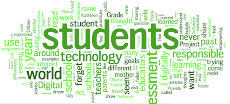Currently we see pockets of school administrators and teachers finding ways around the restrictions placed on them. This to me serves only to exasperate the situation. In discussions with our district's Tech managers, the countless number of times that students have abused their internet access are used as justification for the pretty heavy handed censorship that the filters our district has purchased provide. To me the solution lies in our ability to educate and empower our students to be respectful and responsible digital citizens. This is part of a greater goal to work towards intrinsically motivated students. Something that I have been calling our EduGrail. The holy grail of education. We have yet to discover a one stop shop solution to student misuse of the internet. Along the way we have found pieces of the puzzle. One such piece is the ideas that stem from "Choice Theory".
Choice Theory (originally called Control Theory) was first coined so by William Glasser in the early 1970's. The mega-paraphrasical version of Choice Theory, would state that all behaviour has purpose and that the purpose is to meet one of five needs. The five needs being freedom, fun, belonging, power and physical survival. Now you take Glasser's work with choice theory and reality therapy, an understanding of a personal quality world and the circle of courage from the First Nations and you get an excellent base of knowledge that Diane Gossen (a former student of the Glasser Institute) has masterfully woven together and called "Restitution".
 Restitution has long been thought of as the pay back. However, the Restitution that Gossen teaches is actually a pay forward. She has constructed many strategies to help students be responsible and respectful in the classroom and on the playground. So it only makes sense to work to bring these ideas into the digital world. Gossen's book, "It's All About We" is an important read for all educators. It helps us understand the motivation behind the behaviour and the path to ensuring that if mistakes are made that blame, shame, and punishment are counterproductive. If a child (or anyone for that matter) can repair the relationship that was damaged by the mistake then he/she returns to that community feeling strengthened as does those who's needs were infringed upon. Gossen's ideas are not only for when a mistake is made, but more relevant to this blog post, her ideas serve as an excellent framework for explicitly teaching what it means to be a digitally respectful and responsible citizen. The next several posts will be break down various key concepts from Gossen's resources and how they apply to elementary students using the internet in a responsible and respectful way. Your thoughts on this matter would be greatly appreciated as it would help shape the conversation. There is nothing better than debate to motivate research.
Restitution has long been thought of as the pay back. However, the Restitution that Gossen teaches is actually a pay forward. She has constructed many strategies to help students be responsible and respectful in the classroom and on the playground. So it only makes sense to work to bring these ideas into the digital world. Gossen's book, "It's All About We" is an important read for all educators. It helps us understand the motivation behind the behaviour and the path to ensuring that if mistakes are made that blame, shame, and punishment are counterproductive. If a child (or anyone for that matter) can repair the relationship that was damaged by the mistake then he/she returns to that community feeling strengthened as does those who's needs were infringed upon. Gossen's ideas are not only for when a mistake is made, but more relevant to this blog post, her ideas serve as an excellent framework for explicitly teaching what it means to be a digitally respectful and responsible citizen. The next several posts will be break down various key concepts from Gossen's resources and how they apply to elementary students using the internet in a responsible and respectful way. Your thoughts on this matter would be greatly appreciated as it would help shape the conversation. There is nothing better than debate to motivate research.A caveat to this post. My experience with elementary students using the internet and other digital tools has convinced me that not only do the vast majority of the students use the internet appropriately, but they also are quite savvy when it comes to not being exploited. However, it only takes a minimal number of negative cases to stir up the safety nets. So, really, this is an attempt to create a curriculum that justifies the unfiltered use of the internet to the powers that be.










